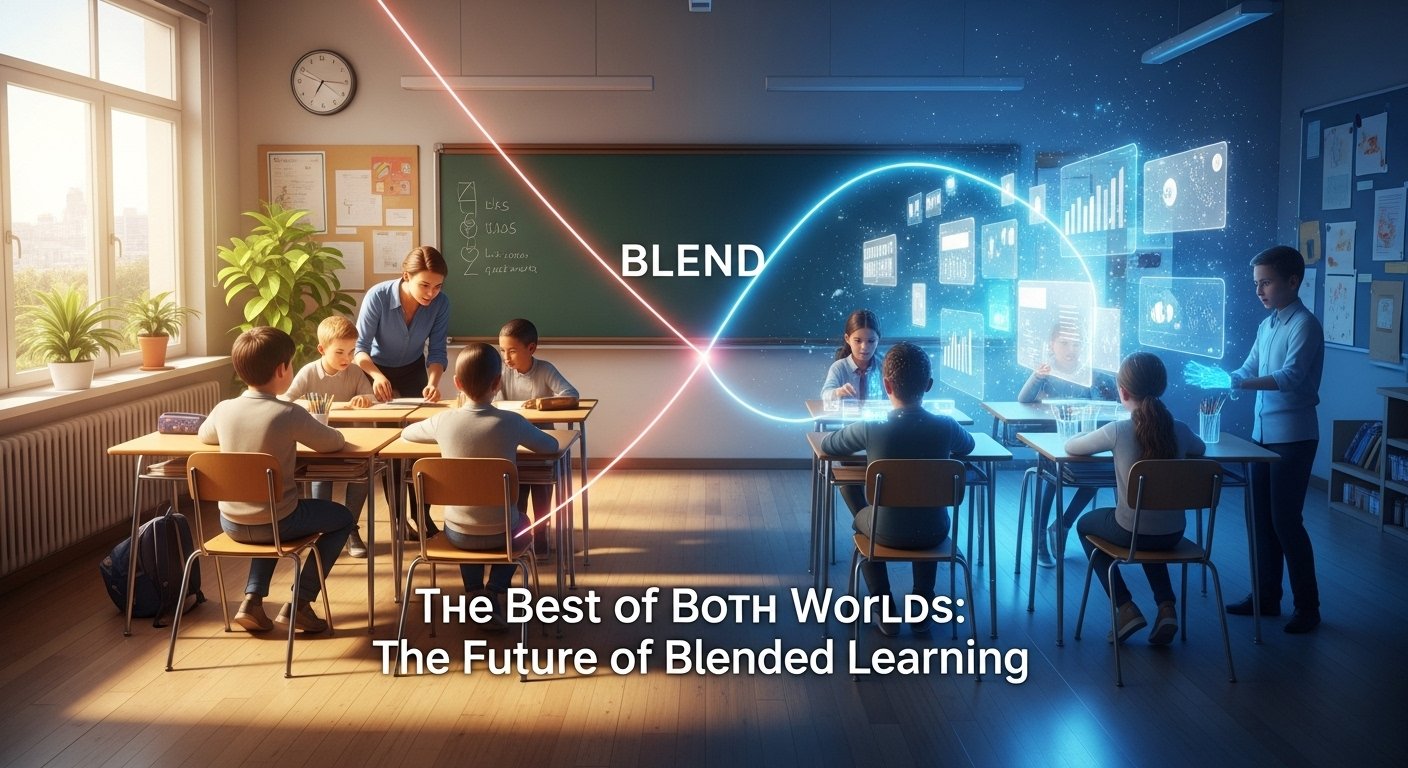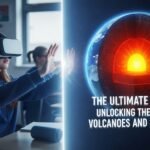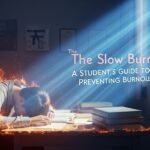The Best of Both Worlds: Why Blended Learning is the Future of Education
Do you remember the early 2020s? For many of us, it was a crash course in the two extremes of education. First, we were plunged into the world of fully remote classes—a landscape of Zoom fatigue, digital isolation, and a constant, nagging feeling of being disconnected. Then, for many, it was a return to the purely traditional classroom, with its rigid, one-pace-fits-all structure that we suddenly saw with fresh eyes. We learned a valuable lesson from that whiplash: neither extreme is the perfect solution. But what if the chaotic experiments of the past few years were actually leading us to a smarter, more resilient, and more effective model? They were. Welcome to the era of blended learning, the thoughtful synthesis of in-person connection and powerful online learning.
As we navigate 2025, blended learning has evolved from an emergency measure into a sophisticated and intentional educational strategy. It’s not just about using computers in the classroom; it’s a fundamental redesign of the learning experience. The core idea is simple but revolutionary: leverage each environment for what it does best. By combining the irreplaceable energy of face-to-face collaboration with the flexible, personalized power of online learning, we can create a more engaging and equitable educational model for all students. This isn’t a compromise; it’s the future.
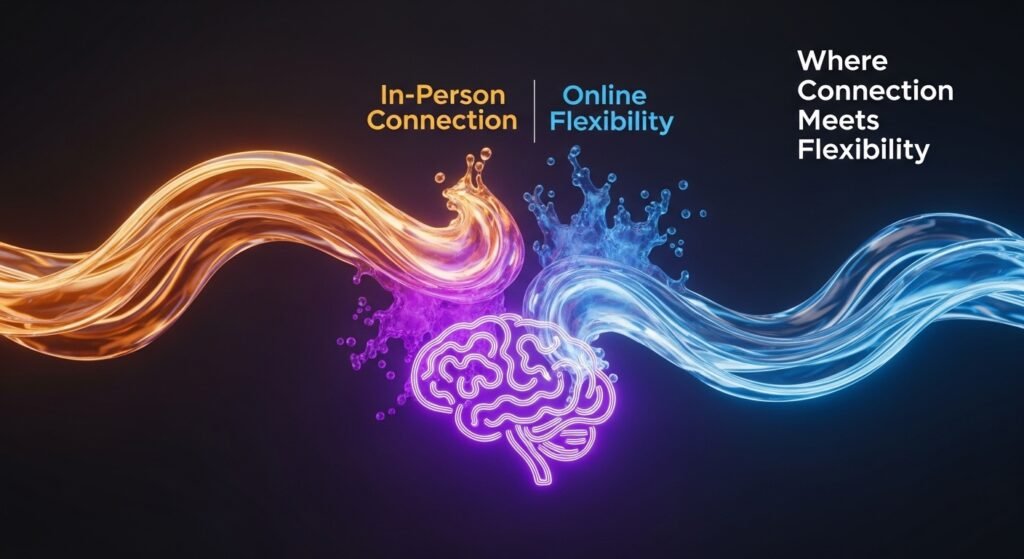
What Blended Learning Really Is (and What It Isn’t)
First, let’s clear up some confusion. Blended learning isn’t just a teacher using a smartboard or students typing essays on laptops. That’s just a tech-rich classroom.
True blended learning, as defined by leading institutions like the Christensen Institute, is a formal education program in which a student learns at least in part through online learning, with some element of student control over time, place, path, or pace. The other part of the learning takes place in a supervised, brick-and-mortar location away from home.
The key is the intentional integration. It’s about a pedagogical shift where the teacher asks: “What is the best use of my face-to-face time with students?” and “What parts of the learning process can be enhanced, personalized, or made more flexible through technology?” It’s a strategic choice, not just a technological add-on.
The Best of Both Worlds: In-Person vs. Online Learning
The genius of the blended model lies in its ability to harness the unique strengths of both the physical and virtual learning environments.
| The Power of In-Person Learning | The Power of Online Learning | The Blended Synthesis |
| Community & Connection: Fosters spontaneous collaboration, debate, and social bonding. | Flexibility & Pace: Allows students to learn anytime, anywhere, and at their own speed. | In-person time is reserved for high-value collaboration; online learning provides flexibility. |
| Immediate Feedback: Teachers can read body language and provide instant, nuanced support. | Data-Driven Personalization: Adaptive software can tailor content and difficulty to individual student needs. | Data from online work informs the teacher’s in-person support, making it highly targeted. |
| Hands-On Learning: Ideal for science labs, studio art, and physical education. | Access to Resources: Provides access to a limitless library of videos, articles, simulations, and experts from around the world. | Students access foundational knowledge online, then apply it in hands-on, in-person labs. |
| Structured Environment: Provides a clear routine and reduces distractions for some students. | Student Agency: Empowers students to take ownership of their learning path and develop self-discipline. | The model provides structure while still giving students significant control over their learning. |
3 Fun Ways to Build a Science Classroom Community
The Blended Learning Playbook: Four Popular Models in Action
Blended learning isn’t a single, rigid formula. It’s a flexible framework with several models that can be adapted to different age groups and subjects. Here are four of the most effective models we’re seeing in US schools today.
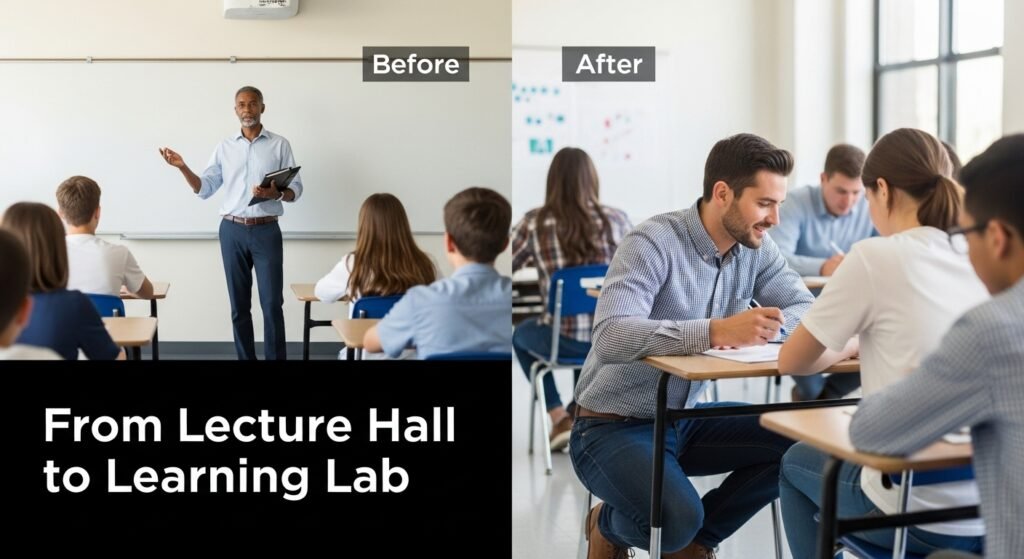
1. The Flipped Classroom
This is the classic blended learning model. The traditional structure of the school day is “flipped” on its head.
- At Home (The Online Learning Component): Students engage with new material independently. This is typically done by watching a lecture video created by their teacher, reading an article, or exploring an interactive simulation.
- In the Classroom (The In-Person Component): Class time, now freed from the lecture, is transformed into a dynamic workshop. Students work on what used to be homework—problem sets, projects, lab experiments, or deep discussions—while the teacher circulates, providing one-on-one and small-group support. This model reserves precious face-to-face time for the most challenging and collaborative parts of the learning process.
3 Fun Ways to Build a Science Classroom Community
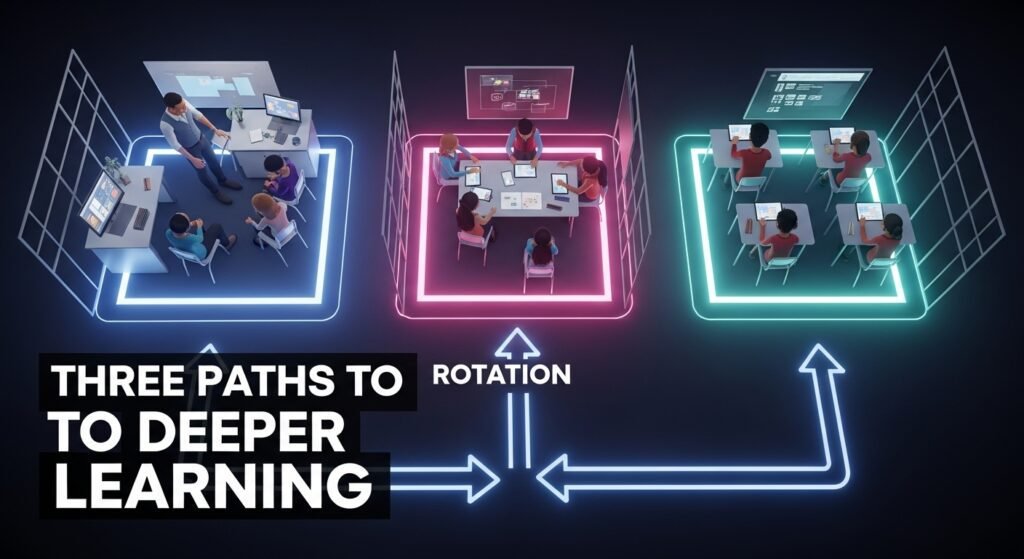
2. The Station Rotation Model
This model is a staple in many elementary and middle school classrooms. Within a single class period, students rotate through several different learning stations.
- Station 1: Teacher-Led Instruction: A small group of students works directly with the teacher on a targeted mini-lesson.
- Station 2: Collaborative Work: Students work together on a group project or a peer-to-peer activity.
- Station 3: Independent Online Learning: Students work on adaptive software, practice skills, or conduct research on their devices. The online learning component allows for powerful differentiation, as each student can be working on a task perfectly matched to their skill level.
3. The Flex Model
This model gives students a high degree of control over their learning. The classroom or “learning lab” is the central hub, but the instruction is delivered primarily online.
- The Learning Environment: Students work independently through a personalized, fluid schedule, accessing their curriculum and lessons via an online learning platform.
- The Teacher’s Role: The teacher is not at the front of the room lecturing. Instead, they act as a facilitator and mentor, pulling together small groups for targeted instruction, providing one-on-one tutoring, and monitoring student progress through a data dashboard. This model is particularly effective for students who thrive with more autonomy.
4. The A La Carte Model
This model allows students to supplement their traditional course load with a course taken entirely online.
- The Scenario: Imagine a student in a small, rural high school that doesn’t have the resources to offer AP Japanese or Advanced Statistics. The A La Carte model allows that student to take the course from an accredited online provider while still participating in their regular school day. This is a powerful tool for educational equity, giving students access to a world of specialized subjects regardless of their geographic location.
A Story from the Classroom: The Day a “Flipped” Lab Changed Everything
Let me tell you about a high school chemistry teacher, Mr. Davies. For years, he faced the same frustrating problem: his 50-minute class period was never enough for a proper lab. By the time he explained the theory, went over the safety procedures, and answered questions, students only had about 20 minutes left for the actual experiment. It was always rushed and stressful.
Then, he decided to “flip” his lab. The week before, he assigned the online learning component: a 15-minute video he recorded where he walked through the entire lab procedure, explained the underlying chemical principles, and covered all the safety warnings. Students were required to watch it and answer a short pre-lab quiz.
When the students walked into the classroom on lab day, the difference was electric. There was no lecture. The equipment was ready, and the students, already equipped with the foundational knowledge, dove straight into the experiment. The entire 50 minutes were dedicated to hands-on discovery, collaboration, and troubleshooting. Mr. Davies was free to engage with each group, ask deeper questions, and witness genuine “aha!” moments. By strategically moving the information delivery online, he transformed his in-person class time into a pure, joyful experience of scientific inquiry.
AI Study Tips for High School to College Transition | Boost Learning in 2025
The Human Element: Making Blended Learning Work for Everyone
For all its benefits, a successful blended learning program is not automatic. It requires a thoughtful approach that prioritizes people over platforms.
- For Teachers, It’s a New Art Form: The role of the blended learning teacher is more complex and dynamic. It requires a shift from being a “sage on the stage” to a “guide on the side.” This transition requires robust professional development, collaborative planning time with colleagues, and strong support from school administration.
- For Students, It’s a New Skill Set: The flexibility of online learning demands strong time management, self-discipline, and digital literacy skills. We can’t just expect students to have these skills; we must intentionally teach and model them.
- Equity is the Foundation: The biggest potential pitfall of any blended model is the digital divide. For any model that requires online learning at home, schools must ensure that every single student has reliable access to a device and high-speed internet. Without this foundation of equity, blended learning risks widening the very gaps it has the potential to close.
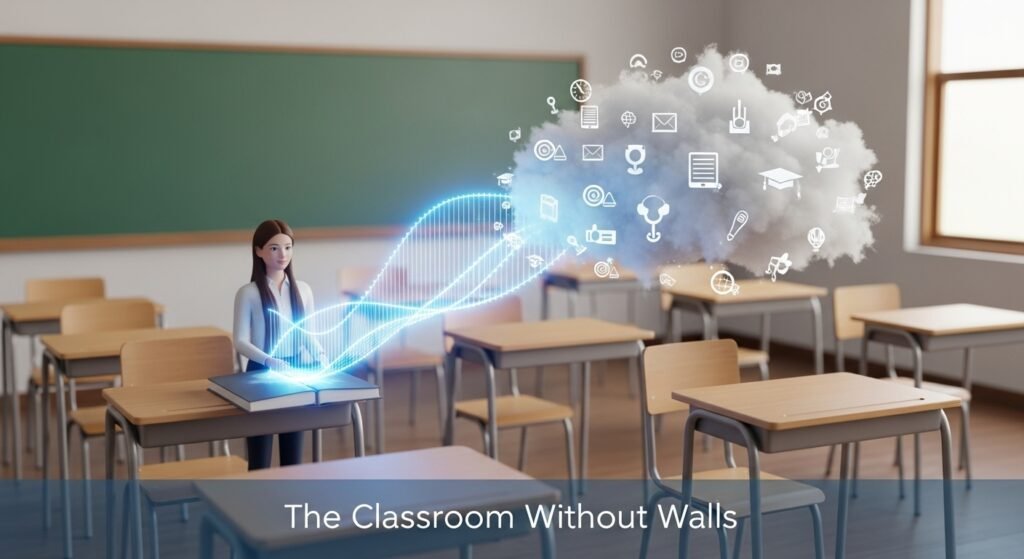
Conclusion: The Thoughtful Future of Education
The chaotic, reactive nature of education in the early 2020s has given way to a more mature and intentional future. Blended learning has emerged not as a compromise, but as the clear-eyed synthesis of what we know works best. It honors the irreplaceable value of the human connection between teacher and student, creating space for that relationship to flourish during in-person time. Simultaneously, it harnesses the power of online learning to create flexible, personalized, and data-informed educational pathways.
By thoughtfully combining these two powerful modalities, we are not just building more resilient schools. We are creating a more engaging, more equitable, and ultimately more effective learning experience that prepares students for a future that is, itself, blended.
For the educators and students reading: What is one part of your class you would love to “flip”? The lecture? The homework? The research process? Share your ideas in the comments below!
AI Study Tips for High School to College Transition | Boost Learning in 2025

